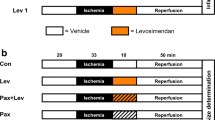Summary
The benzopyran-derivative bimakalim is an ATP-dependent potassium channel activator that has been shown to be a potent arterial vasodilator in anesthetized pigs. In the present study we evaluated the cardiovascular profile of bimakalim in normal concious animals and concious animals with chronic left ventricular dysfunction and compared the results to those obtained with nicorandil. In normal conscious pigs, bimakalim (37.5–300 ng/kg/min, n=6) and nicorandil (10–80 μg/kg/min, n=8) increased cardiac output from 2.7±0.1 l/min to 3.8±0.2 l/min and from 2.7±0.1 l/ min to 3.9±0.3 l/min (both p<.05) due to increases in heart rate (up to 62±14% and 74±9%, respectively, both p<.05). The mean arterial blood pressure decreased gradually from 104±4 mmHg to 91±5 mmHg with bimakalim and from 98 ±3 mmHg to 84±5 mmHg with nicorandil (both p<.05), due to similar decreases in systemic vascular resistance. LVdP/dtmax also increased with both drugs (up to 48±11% and 69±7%, respectively, p<.05), but left ventricular end-diastolic pressure remained unchanged with bimakalim, while it gradually decreased from 9±1 mmHg to 5±1 mmHg (p<.05) with nicorandil.
In pigs with a 3- to 4-week-old myocardial infarction, the vasodilator responses to bimakalim (n=8) and nicorandil (n=9) were not affected, but the increases in heart rate and LVdP/dtmax were attenuated compared to the effects in the normal animals. Nonselective beta-adrenoceptor blockade did not affect the vasodilator capacity and attenuated, although did not abolish, the increases in heart rate and LVdP/dtmax of bimakalim. From the present study we may conclude that in conscious pigs bimakalim was approximately 250 times more potent as an arterial vasodilator than nicorandil. The data also suggest that in the dose range tested, the vasodilator effect outweighs the potential negative inotropic actions of bimakalim and the compound may therefore be of interest in clinical situations that require a lowering of systemic vascular resistance.
Similar content being viewed by others
References
Cook NS. The pharmacology of potassium channels and their therapeutic potential. TIPS 1988;9:21–28.
Buckingham RE, Clapham JC, Hamilton TC, et al. BRL 34915, a novel antihypertensive agent: Comparison of effects on blood pressure and other haemodynamic parameters with those of nifedipine in animal models. J Cardiovasc Pharmacol 1986;8:798–804.
Hamilton TC, Weir SW, Weston AH. Comparison of the effects of BRL 34915 and verapamil on electrical and mechanical activity in rat portal vein. Br J Pharmacol 1986;88:103–111.
Findlay I, Deroubaix E, Guiraudou P, Coraboeuf E. Effects of activation of ATP-sensitive K+ channels in mammalian ventricular myocytes. Am J Physiol 1989;257:H1551-H1559.
De Peyer JE, Lues I, Gericke R, Häusler G. Characterization of a novel K+ channel activator, EMD 52 692, in electrophysiological and pharmacological experiments. Pflügers Arch 1989;414:S191.
Gericke R, Lues I, De Peyer JE, Haeusier G. Electrophysiological and pharmacological characterization of EMD 52 692. A new potassium channel activator. Naunyn-Schmiedeberg's Arch Pharmacol1989;339:R62.
Richer C, Mulder P, Dousseau MP, et al. Systemic and regional haemodynamic interactions between K+ channel openers and the sympathetic nervous system in the SHR. Br J Pharmacol 1990;100:557–563.
Sassen LMA, Duncker DJGM, Gho BCG, et al. Haemodynamic profile of the potassium channel activator EMD 52 692 in anaesthetized pigs. Br J Pharmacol 1990;101:605–614.
Taira N. Nicorandil as a hybrid between nitrates and potassium channel activators. Am J Cardiol 1989;63:18J-24J.
Verdouw PD, Sassen LMA, Duncker DJ, et al. Nicorandil-induced changes in the distribution of cardiac output and coronary blood flow in pigs. Naunyn-Schmiedeberg's Arch Pharmacol 1987;336:352–358.
Van der Giessen WJ, Van Woerkens LJ, Duncker DJ, et al. The acute hemodynamic effect of nisoldipine and pimobendan in conscious pigs with chronic heart failure. J Cardiovasc Pharmacol 1989;14:653–658.
Van Woerkens LJ, Van der Giessen WJ, Verdouw PD. Cardiovascular profile of 5 novel nitrate-esters: A comparative study with nitroglycerin in conscious pigs with and without left ventricular dysfunction. Br J Pharmacol 1991;104:7–14.
Duncker DJ, Saxena PR, Verdouw PD. Systemic haemodynamics of dihydropyridine derivatives in conscious pigs with or without propranolol. Eur J Pharmacol 1987;156:401–409.
Van Woerkens LJ, Schotman SN, Van der Giessen WJ, Verdouw PD. Cardiovascular effects of elgodipine in conscious pigs with a normal coronary circulation and conscious pigs with a healed myocardial infarction. J Cardiovasc Pharmacol 1991;17:976–982.
Sassen LMA, Soei LK, Koning MMG, Verdouw PD. The central and regional cardiovascular responses to intravenous and intracoronary administration of the phenyldihydropyridine elgodipine in anaesthetized pigs. Br J Pharmacol 1990;99:355–363.
Warltier DC, Zyvoloski MG, Gross GJ, Brooks HJ. Comparative actions of dihydropyridine slow channel calcium blocking agents in conscious dogs: Systemic and coronary hemodynamics with and without combined beta-adrenergic blockade. J Pharmacol Exp Ther 1984;230:367–375.
Silke B, Verma SP, Midtbo KA, et al. A haemodynamic study of the effects of combined slow channel blockade (nisoldipine) and beta-blockade (metoprolol) in coronary heart disease. Int J Cardiol 1986;13:231–241.
Nakaya H, Schwartz A, Millard RW. Reflex chronotropic and inotropic effects of calcium channel-blocking agents in conscious dogs. Diltiazem, verapamil and nifedipine compared. Circ Res 1983;52:302–311.
Yanagisawa T, Hashimoto H, Taira N. The negative inotropic effect of nicorandil is independent of cyclic GMP changes: A comparison with pinacidil and cromakalim in canine atrial tissue. Br J Pharmacol 1988;95:393–398.
Gotanda K, Satoh K, Taira N. Is the cardiovascular profile of BRL 34915 characteristic of potassium channel activation? J Cardiovasc Pharmacol 1988;12:239–246.
Scheffer MG, Verdouw PD. Decreased incidence of ventricular fibrillation after an acute coronary artery ligation in exercised pigs. Basic Res Cardiol 1983;78:298–309.
Van Woerkens LJ, Van der Giessen WJ, Verdouw PD. The selective bradycardic effects of (zatebradine) UL-FS 49 do not adversely affect left ventricular function in conscious pigs with chronic coronary artery occlusion. Cardiovasc Drugs Ther 1992;6:59–65.
Author information
Authors and Affiliations
Rights and permissions
About this article
Cite this article
van Woerkens, L.J., Baas, N.R.A., van der Giessen, W.J. et al. Cardiovascular effects of the novel potassium channel opener bimakalim in conscious pigs after myocardial infarction: A comparative study with nicorandil. Cardiovasc Drug Ther 6, 409–417 (1992). https://doi.org/10.1007/BF00054190
Issue Date:
DOI: https://doi.org/10.1007/BF00054190




